Report on Facilitating a Group: Stages, Challenges, and Leadership
VerifiedAdded on 2022/09/11
|9
|1521
|28
Report
AI Summary
This report provides a detailed analysis of group facilitation, exploring various aspects such as the importance of reflection in group settings, the significance of group norms (explicit and implicit), and factors affecting effective group formation. The report also discusses potential challenges in group participation, offering suggestions for improvement, and outlines the five stages of group development (Forming, Storming, Norming, Performing, and Adjourning). Furthermore, it highlights essential traits of an effective group facilitator, maintenance functions, and leadership qualities across different age groups. The report emphasizes the importance of inclusion and diversity in group work and concludes with a discussion on the purpose and benefits of group planning sessions.
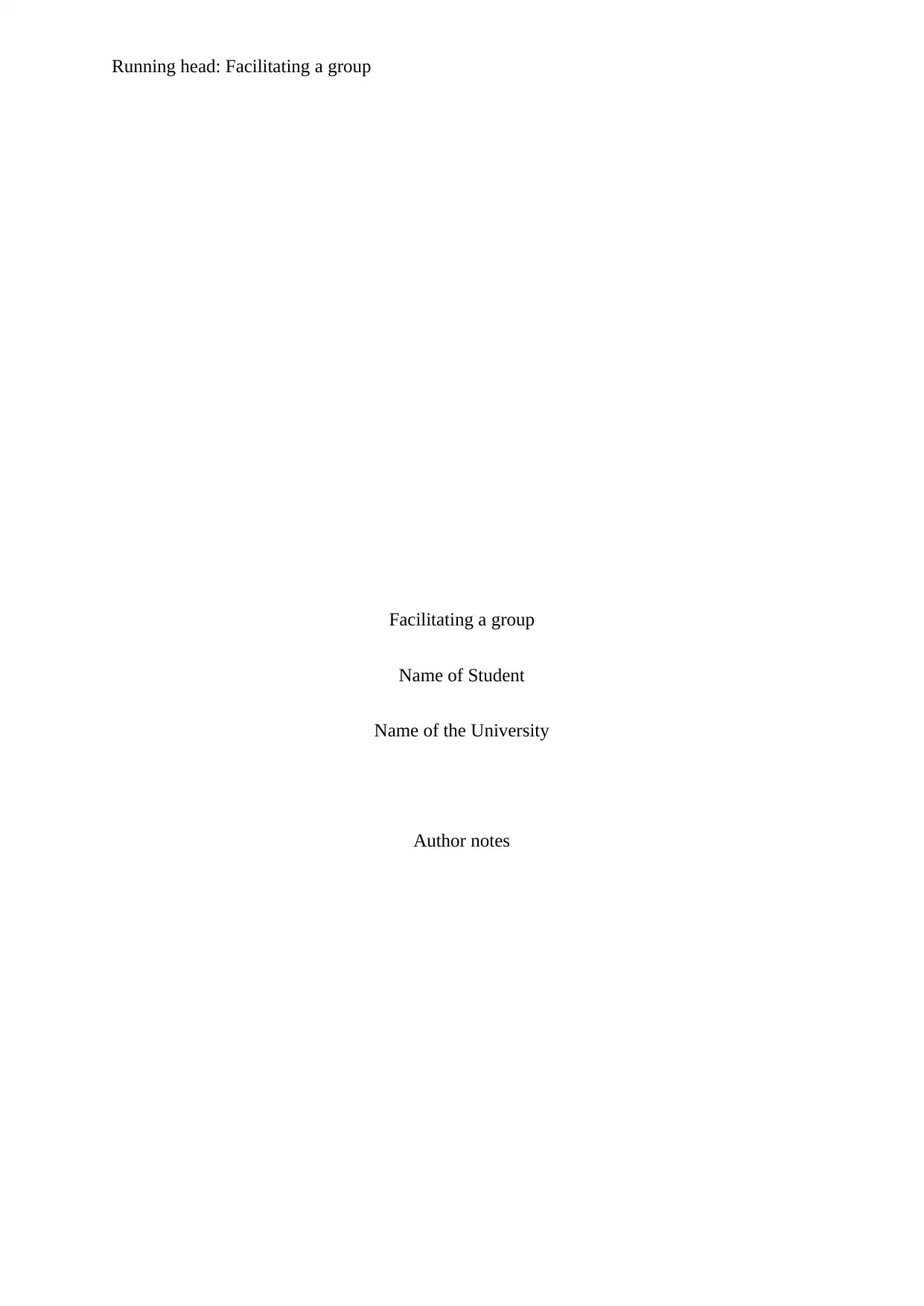
Running head: Facilitating a group
Facilitating a group
Name of Student
Name of the University
Author notes
Facilitating a group
Name of Student
Name of the University
Author notes
Paraphrase This Document
Need a fresh take? Get an instant paraphrase of this document with our AI Paraphraser
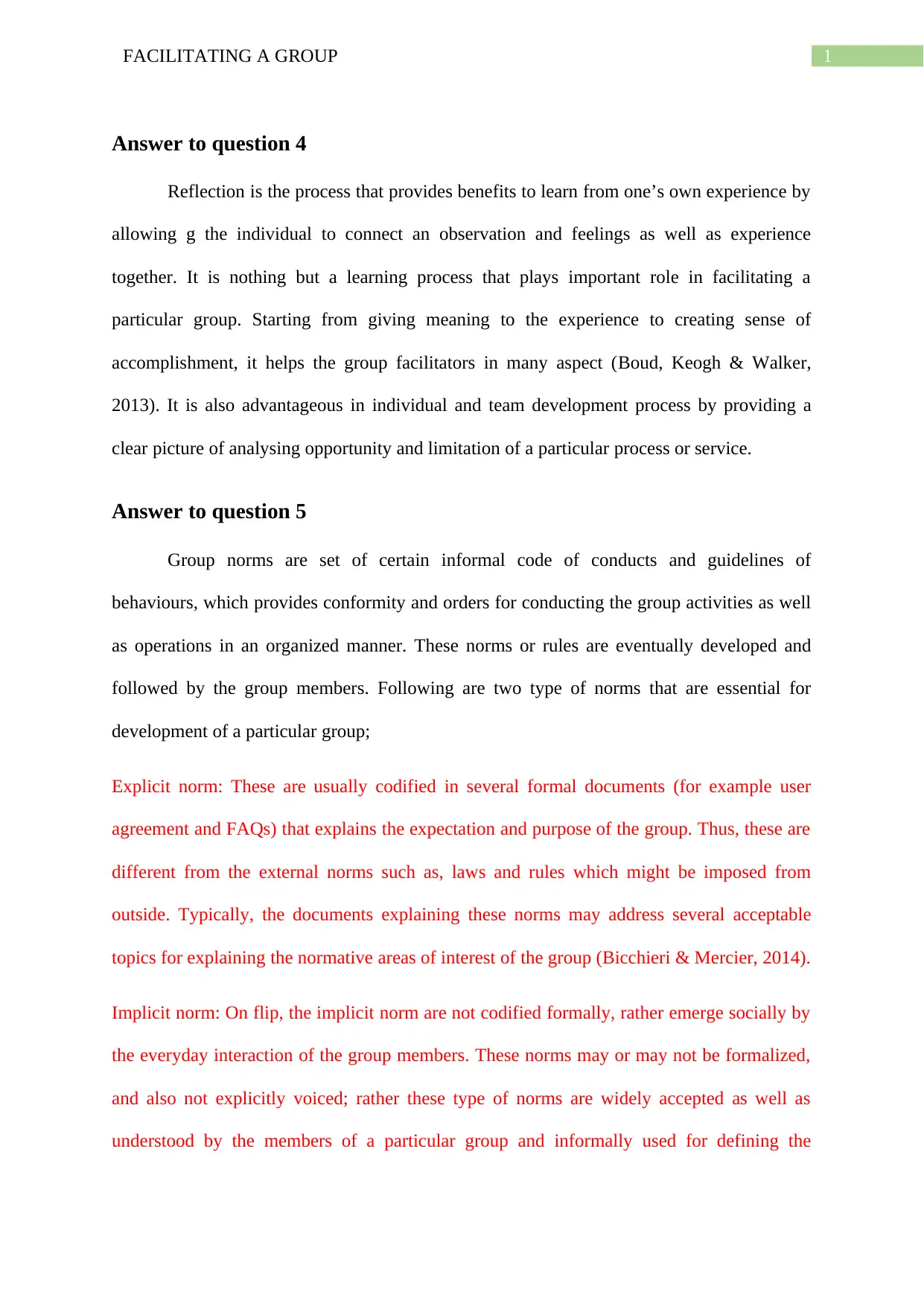
1FACILITATING A GROUP
Answer to question 4
Reflection is the process that provides benefits to learn from one’s own experience by
allowing g the individual to connect an observation and feelings as well as experience
together. It is nothing but a learning process that plays important role in facilitating a
particular group. Starting from giving meaning to the experience to creating sense of
accomplishment, it helps the group facilitators in many aspect (Boud, Keogh & Walker,
2013). It is also advantageous in individual and team development process by providing a
clear picture of analysing opportunity and limitation of a particular process or service.
Answer to question 5
Group norms are set of certain informal code of conducts and guidelines of
behaviours, which provides conformity and orders for conducting the group activities as well
as operations in an organized manner. These norms or rules are eventually developed and
followed by the group members. Following are two type of norms that are essential for
development of a particular group;
Explicit norm: These are usually codified in several formal documents (for example user
agreement and FAQs) that explains the expectation and purpose of the group. Thus, these are
different from the external norms such as, laws and rules which might be imposed from
outside. Typically, the documents explaining these norms may address several acceptable
topics for explaining the normative areas of interest of the group (Bicchieri & Mercier, 2014).
Implicit norm: On flip, the implicit norm are not codified formally, rather emerge socially by
the everyday interaction of the group members. These norms may or may not be formalized,
and also not explicitly voiced; rather these type of norms are widely accepted as well as
understood by the members of a particular group and informally used for defining the
Answer to question 4
Reflection is the process that provides benefits to learn from one’s own experience by
allowing g the individual to connect an observation and feelings as well as experience
together. It is nothing but a learning process that plays important role in facilitating a
particular group. Starting from giving meaning to the experience to creating sense of
accomplishment, it helps the group facilitators in many aspect (Boud, Keogh & Walker,
2013). It is also advantageous in individual and team development process by providing a
clear picture of analysing opportunity and limitation of a particular process or service.
Answer to question 5
Group norms are set of certain informal code of conducts and guidelines of
behaviours, which provides conformity and orders for conducting the group activities as well
as operations in an organized manner. These norms or rules are eventually developed and
followed by the group members. Following are two type of norms that are essential for
development of a particular group;
Explicit norm: These are usually codified in several formal documents (for example user
agreement and FAQs) that explains the expectation and purpose of the group. Thus, these are
different from the external norms such as, laws and rules which might be imposed from
outside. Typically, the documents explaining these norms may address several acceptable
topics for explaining the normative areas of interest of the group (Bicchieri & Mercier, 2014).
Implicit norm: On flip, the implicit norm are not codified formally, rather emerge socially by
the everyday interaction of the group members. These norms may or may not be formalized,
and also not explicitly voiced; rather these type of norms are widely accepted as well as
understood by the members of a particular group and informally used for defining the
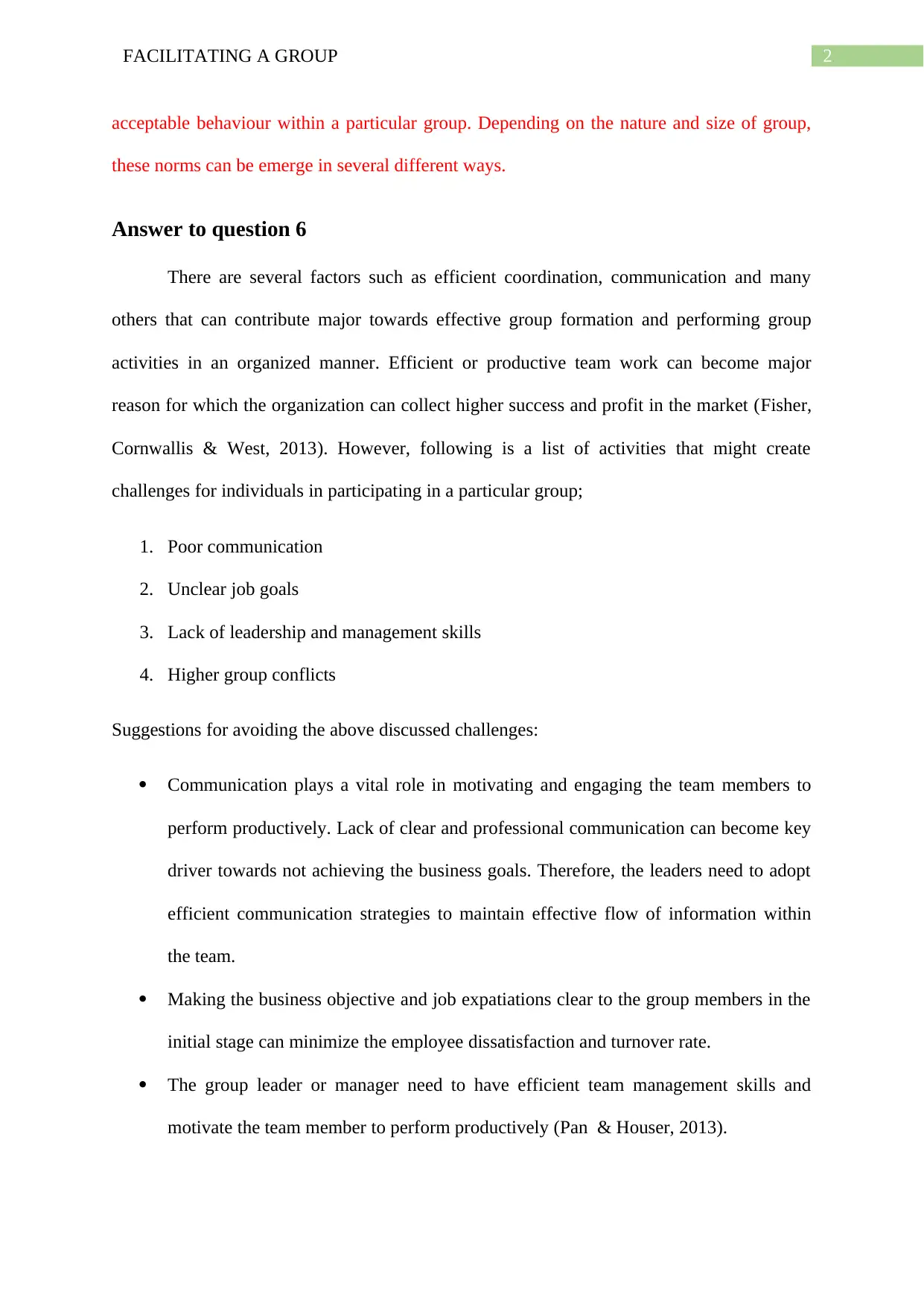
2FACILITATING A GROUP
acceptable behaviour within a particular group. Depending on the nature and size of group,
these norms can be emerge in several different ways.
Answer to question 6
There are several factors such as efficient coordination, communication and many
others that can contribute major towards effective group formation and performing group
activities in an organized manner. Efficient or productive team work can become major
reason for which the organization can collect higher success and profit in the market (Fisher,
Cornwallis & West, 2013). However, following is a list of activities that might create
challenges for individuals in participating in a particular group;
1. Poor communication
2. Unclear job goals
3. Lack of leadership and management skills
4. Higher group conflicts
Suggestions for avoiding the above discussed challenges:
Communication plays a vital role in motivating and engaging the team members to
perform productively. Lack of clear and professional communication can become key
driver towards not achieving the business goals. Therefore, the leaders need to adopt
efficient communication strategies to maintain effective flow of information within
the team.
Making the business objective and job expatiations clear to the group members in the
initial stage can minimize the employee dissatisfaction and turnover rate.
The group leader or manager need to have efficient team management skills and
motivate the team member to perform productively (Pan & Houser, 2013).
acceptable behaviour within a particular group. Depending on the nature and size of group,
these norms can be emerge in several different ways.
Answer to question 6
There are several factors such as efficient coordination, communication and many
others that can contribute major towards effective group formation and performing group
activities in an organized manner. Efficient or productive team work can become major
reason for which the organization can collect higher success and profit in the market (Fisher,
Cornwallis & West, 2013). However, following is a list of activities that might create
challenges for individuals in participating in a particular group;
1. Poor communication
2. Unclear job goals
3. Lack of leadership and management skills
4. Higher group conflicts
Suggestions for avoiding the above discussed challenges:
Communication plays a vital role in motivating and engaging the team members to
perform productively. Lack of clear and professional communication can become key
driver towards not achieving the business goals. Therefore, the leaders need to adopt
efficient communication strategies to maintain effective flow of information within
the team.
Making the business objective and job expatiations clear to the group members in the
initial stage can minimize the employee dissatisfaction and turnover rate.
The group leader or manager need to have efficient team management skills and
motivate the team member to perform productively (Pan & Houser, 2013).
⊘ This is a preview!⊘
Do you want full access?
Subscribe today to unlock all pages.

Trusted by 1+ million students worldwide
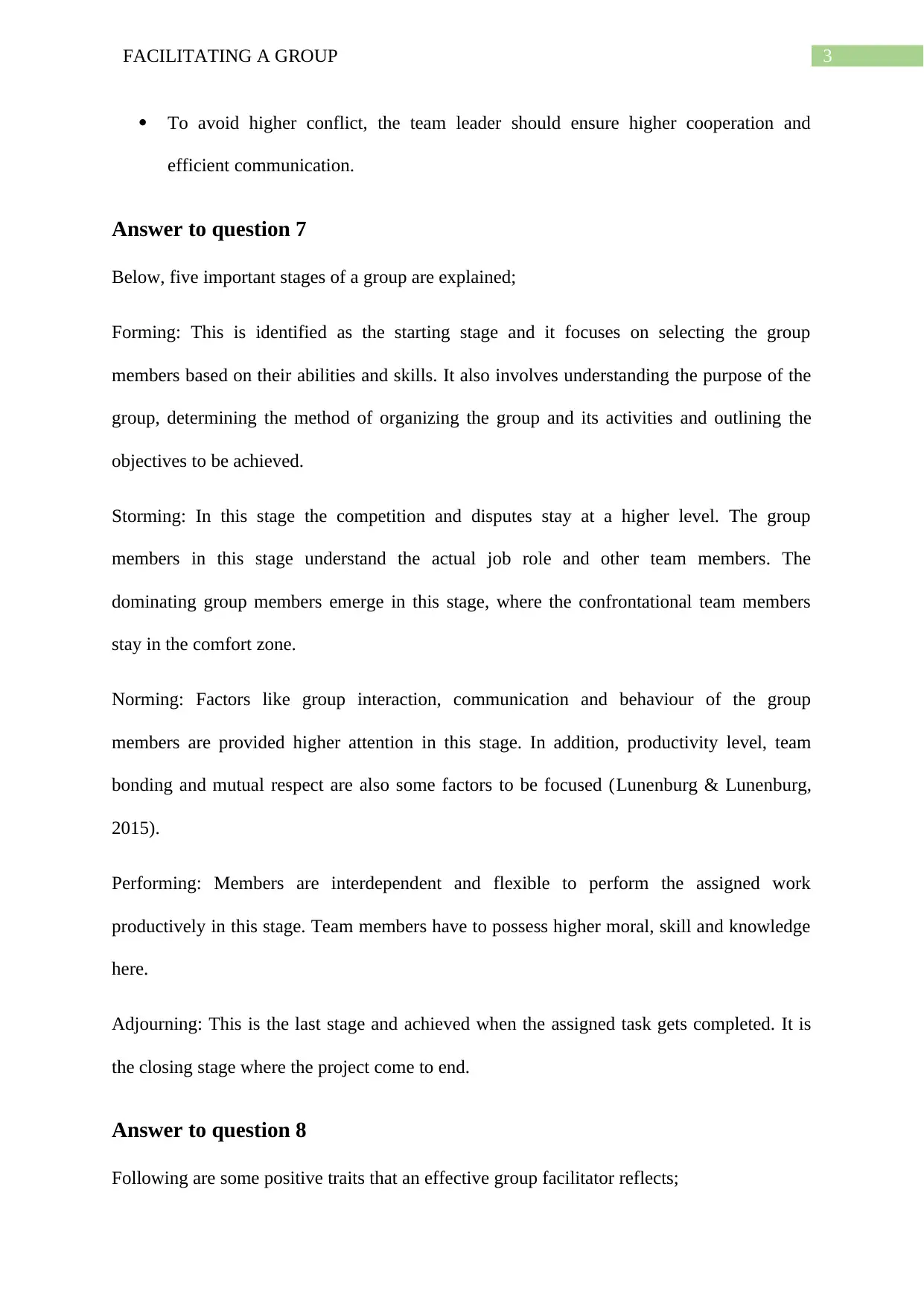
3FACILITATING A GROUP
To avoid higher conflict, the team leader should ensure higher cooperation and
efficient communication.
Answer to question 7
Below, five important stages of a group are explained;
Forming: This is identified as the starting stage and it focuses on selecting the group
members based on their abilities and skills. It also involves understanding the purpose of the
group, determining the method of organizing the group and its activities and outlining the
objectives to be achieved.
Storming: In this stage the competition and disputes stay at a higher level. The group
members in this stage understand the actual job role and other team members. The
dominating group members emerge in this stage, where the confrontational team members
stay in the comfort zone.
Norming: Factors like group interaction, communication and behaviour of the group
members are provided higher attention in this stage. In addition, productivity level, team
bonding and mutual respect are also some factors to be focused (Lunenburg & Lunenburg,
2015).
Performing: Members are interdependent and flexible to perform the assigned work
productively in this stage. Team members have to possess higher moral, skill and knowledge
here.
Adjourning: This is the last stage and achieved when the assigned task gets completed. It is
the closing stage where the project come to end.
Answer to question 8
Following are some positive traits that an effective group facilitator reflects;
To avoid higher conflict, the team leader should ensure higher cooperation and
efficient communication.
Answer to question 7
Below, five important stages of a group are explained;
Forming: This is identified as the starting stage and it focuses on selecting the group
members based on their abilities and skills. It also involves understanding the purpose of the
group, determining the method of organizing the group and its activities and outlining the
objectives to be achieved.
Storming: In this stage the competition and disputes stay at a higher level. The group
members in this stage understand the actual job role and other team members. The
dominating group members emerge in this stage, where the confrontational team members
stay in the comfort zone.
Norming: Factors like group interaction, communication and behaviour of the group
members are provided higher attention in this stage. In addition, productivity level, team
bonding and mutual respect are also some factors to be focused (Lunenburg & Lunenburg,
2015).
Performing: Members are interdependent and flexible to perform the assigned work
productively in this stage. Team members have to possess higher moral, skill and knowledge
here.
Adjourning: This is the last stage and achieved when the assigned task gets completed. It is
the closing stage where the project come to end.
Answer to question 8
Following are some positive traits that an effective group facilitator reflects;
Paraphrase This Document
Need a fresh take? Get an instant paraphrase of this document with our AI Paraphraser
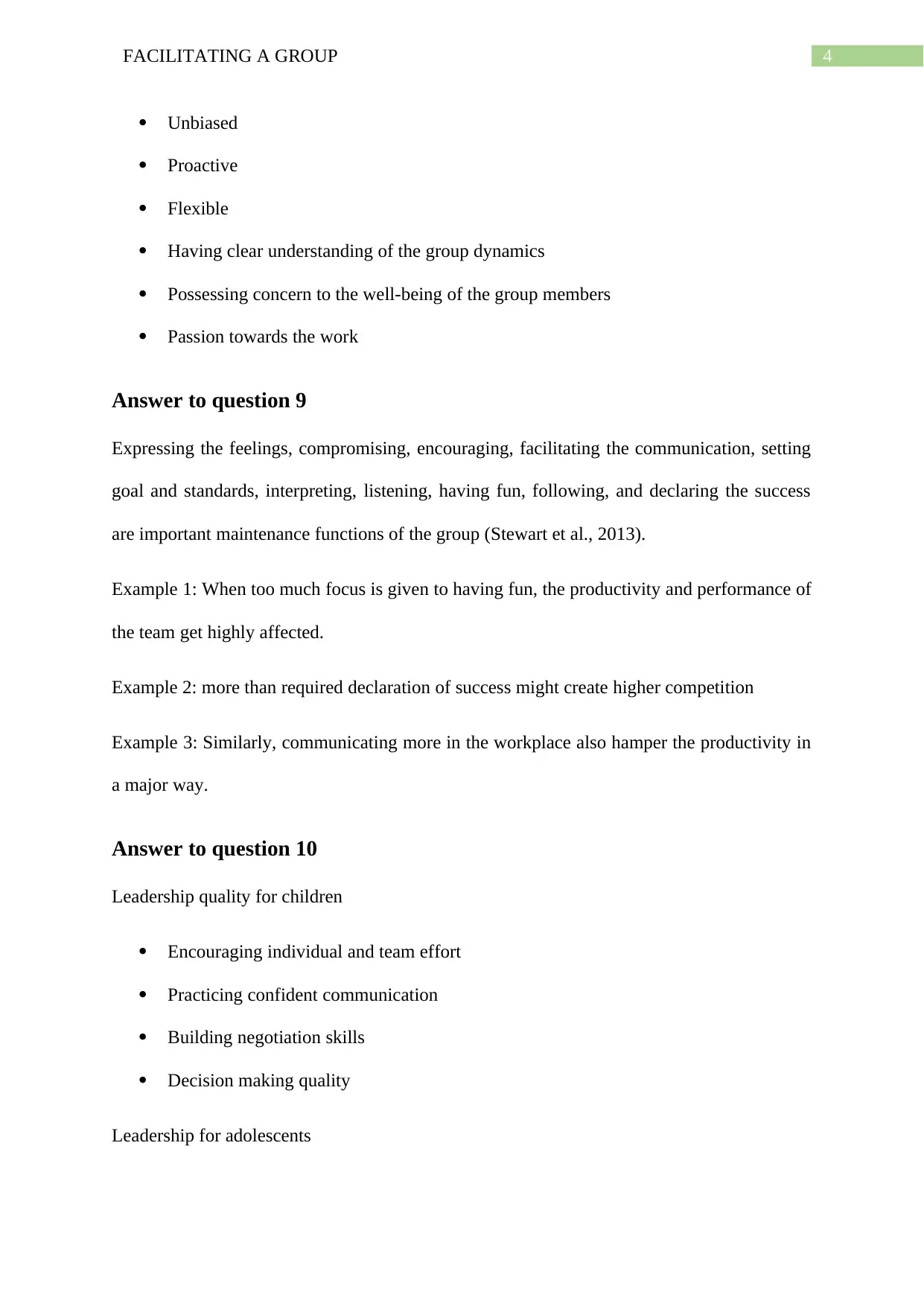
4FACILITATING A GROUP
Unbiased
Proactive
Flexible
Having clear understanding of the group dynamics
Possessing concern to the well-being of the group members
Passion towards the work
Answer to question 9
Expressing the feelings, compromising, encouraging, facilitating the communication, setting
goal and standards, interpreting, listening, having fun, following, and declaring the success
are important maintenance functions of the group (Stewart et al., 2013).
Example 1: When too much focus is given to having fun, the productivity and performance of
the team get highly affected.
Example 2: more than required declaration of success might create higher competition
Example 3: Similarly, communicating more in the workplace also hamper the productivity in
a major way.
Answer to question 10
Leadership quality for children
Encouraging individual and team effort
Practicing confident communication
Building negotiation skills
Decision making quality
Leadership for adolescents
Unbiased
Proactive
Flexible
Having clear understanding of the group dynamics
Possessing concern to the well-being of the group members
Passion towards the work
Answer to question 9
Expressing the feelings, compromising, encouraging, facilitating the communication, setting
goal and standards, interpreting, listening, having fun, following, and declaring the success
are important maintenance functions of the group (Stewart et al., 2013).
Example 1: When too much focus is given to having fun, the productivity and performance of
the team get highly affected.
Example 2: more than required declaration of success might create higher competition
Example 3: Similarly, communicating more in the workplace also hamper the productivity in
a major way.
Answer to question 10
Leadership quality for children
Encouraging individual and team effort
Practicing confident communication
Building negotiation skills
Decision making quality
Leadership for adolescents
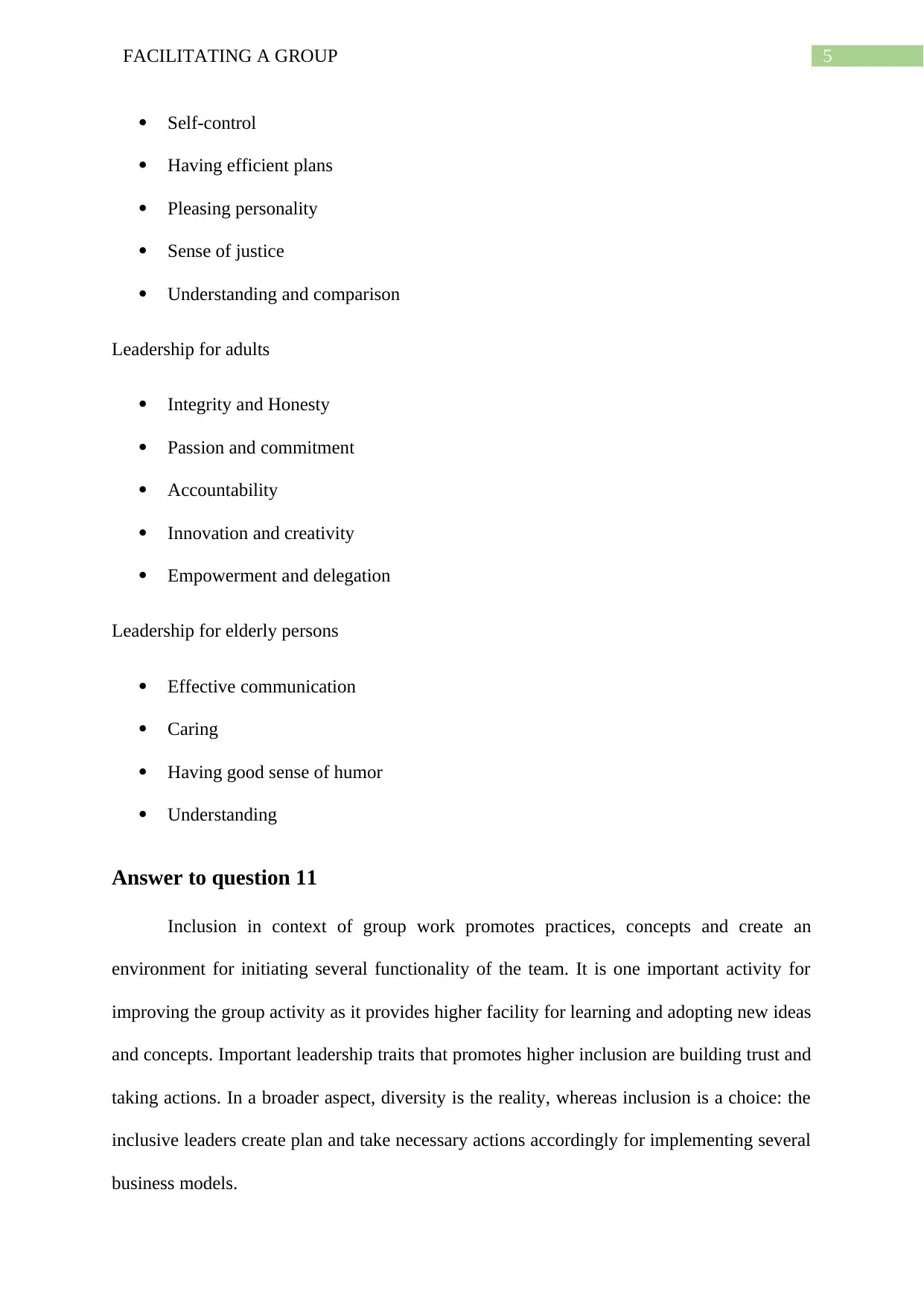
5FACILITATING A GROUP
Self-control
Having efficient plans
Pleasing personality
Sense of justice
Understanding and comparison
Leadership for adults
Integrity and Honesty
Passion and commitment
Accountability
Innovation and creativity
Empowerment and delegation
Leadership for elderly persons
Effective communication
Caring
Having good sense of humor
Understanding
Answer to question 11
Inclusion in context of group work promotes practices, concepts and create an
environment for initiating several functionality of the team. It is one important activity for
improving the group activity as it provides higher facility for learning and adopting new ideas
and concepts. Important leadership traits that promotes higher inclusion are building trust and
taking actions. In a broader aspect, diversity is the reality, whereas inclusion is a choice: the
inclusive leaders create plan and take necessary actions accordingly for implementing several
business models.
Self-control
Having efficient plans
Pleasing personality
Sense of justice
Understanding and comparison
Leadership for adults
Integrity and Honesty
Passion and commitment
Accountability
Innovation and creativity
Empowerment and delegation
Leadership for elderly persons
Effective communication
Caring
Having good sense of humor
Understanding
Answer to question 11
Inclusion in context of group work promotes practices, concepts and create an
environment for initiating several functionality of the team. It is one important activity for
improving the group activity as it provides higher facility for learning and adopting new ideas
and concepts. Important leadership traits that promotes higher inclusion are building trust and
taking actions. In a broader aspect, diversity is the reality, whereas inclusion is a choice: the
inclusive leaders create plan and take necessary actions accordingly for implementing several
business models.
⊘ This is a preview!⊘
Do you want full access?
Subscribe today to unlock all pages.

Trusted by 1+ million students worldwide
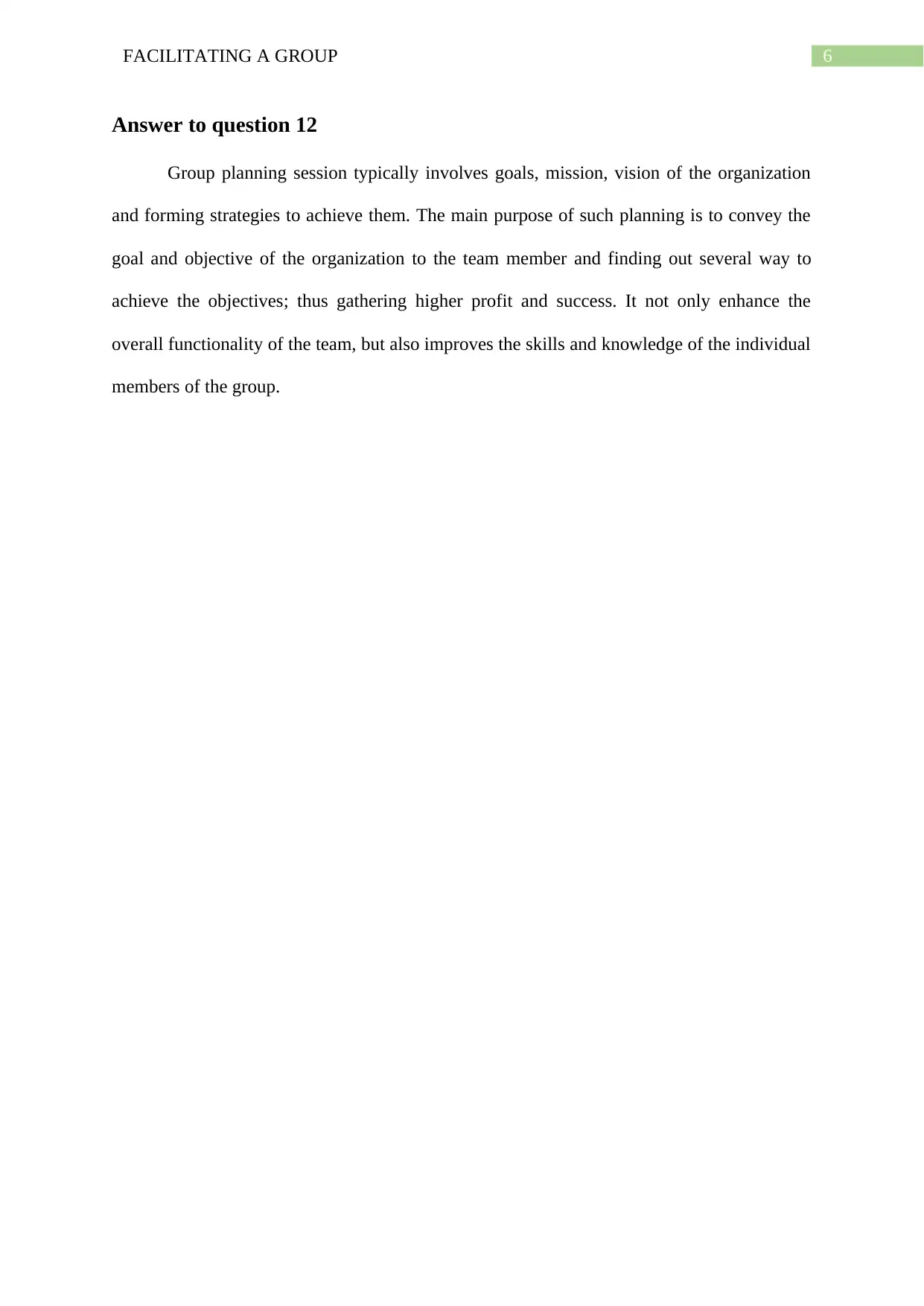
6FACILITATING A GROUP
Answer to question 12
Group planning session typically involves goals, mission, vision of the organization
and forming strategies to achieve them. The main purpose of such planning is to convey the
goal and objective of the organization to the team member and finding out several way to
achieve the objectives; thus gathering higher profit and success. It not only enhance the
overall functionality of the team, but also improves the skills and knowledge of the individual
members of the group.
Answer to question 12
Group planning session typically involves goals, mission, vision of the organization
and forming strategies to achieve them. The main purpose of such planning is to convey the
goal and objective of the organization to the team member and finding out several way to
achieve the objectives; thus gathering higher profit and success. It not only enhance the
overall functionality of the team, but also improves the skills and knowledge of the individual
members of the group.
Paraphrase This Document
Need a fresh take? Get an instant paraphrase of this document with our AI Paraphraser
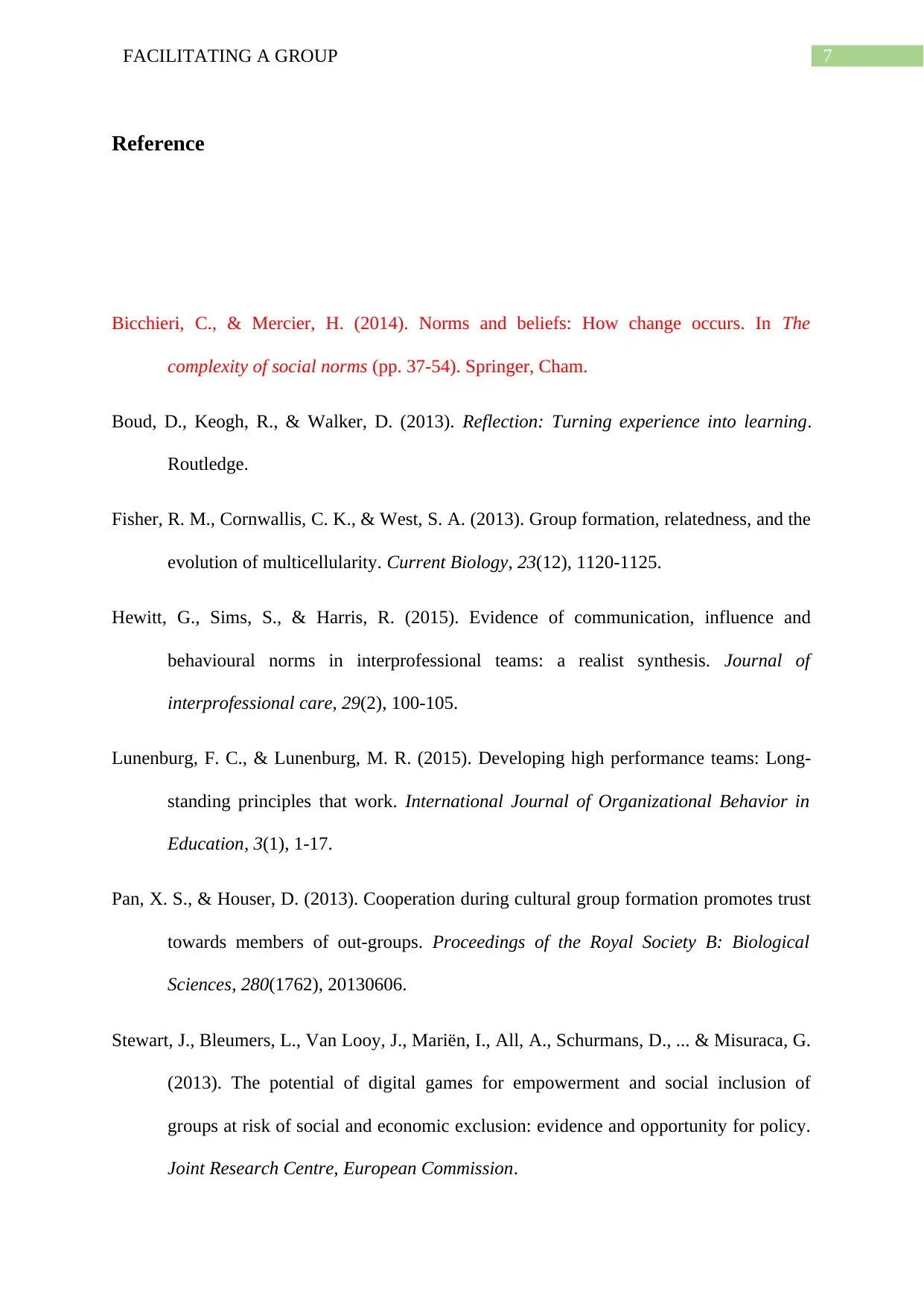
7FACILITATING A GROUP
Reference
Bicchieri, C., & Mercier, H. (2014). Norms and beliefs: How change occurs. In The
complexity of social norms (pp. 37-54). Springer, Cham.
Boud, D., Keogh, R., & Walker, D. (2013). Reflection: Turning experience into learning.
Routledge.
Fisher, R. M., Cornwallis, C. K., & West, S. A. (2013). Group formation, relatedness, and the
evolution of multicellularity. Current Biology, 23(12), 1120-1125.
Hewitt, G., Sims, S., & Harris, R. (2015). Evidence of communication, influence and
behavioural norms in interprofessional teams: a realist synthesis. Journal of
interprofessional care, 29(2), 100-105.
Lunenburg, F. C., & Lunenburg, M. R. (2015). Developing high performance teams: Long-
standing principles that work. International Journal of Organizational Behavior in
Education, 3(1), 1-17.
Pan, X. S., & Houser, D. (2013). Cooperation during cultural group formation promotes trust
towards members of out-groups. Proceedings of the Royal Society B: Biological
Sciences, 280(1762), 20130606.
Stewart, J., Bleumers, L., Van Looy, J., Mariën, I., All, A., Schurmans, D., ... & Misuraca, G.
(2013). The potential of digital games for empowerment and social inclusion of
groups at risk of social and economic exclusion: evidence and opportunity for policy.
Joint Research Centre, European Commission.
Reference
Bicchieri, C., & Mercier, H. (2014). Norms and beliefs: How change occurs. In The
complexity of social norms (pp. 37-54). Springer, Cham.
Boud, D., Keogh, R., & Walker, D. (2013). Reflection: Turning experience into learning.
Routledge.
Fisher, R. M., Cornwallis, C. K., & West, S. A. (2013). Group formation, relatedness, and the
evolution of multicellularity. Current Biology, 23(12), 1120-1125.
Hewitt, G., Sims, S., & Harris, R. (2015). Evidence of communication, influence and
behavioural norms in interprofessional teams: a realist synthesis. Journal of
interprofessional care, 29(2), 100-105.
Lunenburg, F. C., & Lunenburg, M. R. (2015). Developing high performance teams: Long-
standing principles that work. International Journal of Organizational Behavior in
Education, 3(1), 1-17.
Pan, X. S., & Houser, D. (2013). Cooperation during cultural group formation promotes trust
towards members of out-groups. Proceedings of the Royal Society B: Biological
Sciences, 280(1762), 20130606.
Stewart, J., Bleumers, L., Van Looy, J., Mariën, I., All, A., Schurmans, D., ... & Misuraca, G.
(2013). The potential of digital games for empowerment and social inclusion of
groups at risk of social and economic exclusion: evidence and opportunity for policy.
Joint Research Centre, European Commission.

8FACILITATING A GROUP
⊘ This is a preview!⊘
Do you want full access?
Subscribe today to unlock all pages.

Trusted by 1+ million students worldwide
1 out of 9
Related Documents
Your All-in-One AI-Powered Toolkit for Academic Success.
+13062052269
info@desklib.com
Available 24*7 on WhatsApp / Email
![[object Object]](/_next/static/media/star-bottom.7253800d.svg)
Unlock your academic potential
Copyright © 2020–2025 A2Z Services. All Rights Reserved. Developed and managed by ZUCOL.





